Extract from The Guardian
Ludmila and Alevtina live in an ancient cabin,
chopping logs, picking berries and covering anything electronic with
a doily. Nadia Sablin’s shots of her indomitable aunties show a way
of life splendidly untouched by progress
‘It’s hard to imagine they’ll one day be
gone’ … the sisters complete a crossword in an image from the
photobook Aunties. All photographs: Nadia Sablin
Saturday 7 November 2015 03.43 AEDT
In 1952, Nadia
Sablin’s grandfather, Alexey, who had been badly wounded on the
Russian front during the first world war, decided to return home to
the village of Alyokhovshchina where he grew up.
“He took his house apart, log by log, a Roman
numeral carved into each one, floated it down the Oyat river and
reconstructed it,” writes Sablin in her photobook, Aunties:
The Seven Summers of Alevtina and Ludmila. It is there, more than
60 years later, that her book is set – in a rural world remarkably
untouched by progress.
Sablin’s aunties, Alevtina and Ludmila, who are
in their 70s, spend every summer in the house, repairing it by hand,
working the fields around it, chopping wood for the fire and carrying
water from the well. In the evenings they make soup and do crosswords
or embroidery. A small TV set on which they watch Russian soaps is
their only link to the world of technology and information.
“My father tries to pull his sisters into the
present by buying them laptops and Kindles,” says Sablin, “but
they bravely defy him by covering the offending objects with doilies
and carrying on as before.”
Sablin, who was born in Russia but now lives in
Brooklyn, started photographing her elderly aunties in 2008. She
cites magic realist authors such as Mikhail
Bulgakov and Gabriel
García Márquez as influences, and indeed the intimate domestic
world she evokes is both quotidian and luminous. Her portraits mainly
show moments when the women have stopped
for a breather, or are relaxing
at night. They are so at ease with her camera that they even
become willing collaborators in her more choreographed shots, in
which she recreates
scenes from her childhood.
“I can only see them the way I see them, and
while I make no claim to objectivity, I do try to photograph
everything they do with minimum interference,” she says. “But
when I’m in the village, I don’t think I see reality objectively.
There are too many childhood memories around – too many stories I
read or made up, Fenimore
Cooper novels I re-enacted in the woods, mermaids imagined in the
streams and bog devils along the paths. It’s through this mist that
I photograph my aunts’ everyday reality.”
That reality cannot but seem romantic to us, not
least because it is so arrested in a lost time (the
floral dresses and tablecloths, the lives free of relentless
digital distraction) but also because they live simply amid bountiful
nature – their
apple trees are loaded with fruit and their meadow full of fennel
and wild garlic. We see them hard at work, too, sawing
wood they have carried from the sawmill.
And we see the
lines on their faces and feel their fragile sense of
interdependency against the encroaching solitude of old age.
What shines through most strongly in the book is
her admiration for these indomitable women. The book moves
effortlessly from close observation of objects – two
bowls of borscht on a faded tabletop, sheets
drying in a shed – to intimate documentary – an aunt
bent in concentration over a crossword – and from dark
interiors to almost
other-worldly daylight.
I first encountered Sablin’s work in 2013 when I
put her forward for the Daylight
Photography award, and was on the jury that chose her as the
winner
of the Firecracker award. She has since won the Centre
for Documentary Studies/Honickman First Book prize, which led to
the making of Aunties.
“She chooses to show their way of living as almost enchanted; we can hardly believe that what we see in these pictures will ever disappear,” says the curator Sandra S Phillips, who selected Sablin for the first book prize. And yet the older, slower, more insular world that Alevtina and Ludmila represent is fading into history.
“She chooses to show their way of living as almost enchanted; we can hardly believe that what we see in these pictures will ever disappear,” says the curator Sandra S Phillips, who selected Sablin for the first book prize. And yet the older, slower, more insular world that Alevtina and Ludmila represent is fading into history.
“Many rural people in Russia
do live in similar conditions,” explains Sablin, “but most have
embraced newer technology – and wardrobes. A chainsaw is the tool
of choice, and weed-whackers long ago replaced scythes and sickles.
Most of the villagers have installed plumbing and put in a washing
machine. The neighbours do grow their own food, but since a
supermarket was built, it’s cheaper to buy Polish potatoes and
Bulgarian peppers than try to grow your own in sandy soil and with
frequent heatwaves.”
Aunties is an elegy for a way of life as much as a
loving homage to the women who embody it. “I know, of course, that
everyone dies,” says Sablin, “but when I see my aunts looking the
same, in the same house, doing the exact things I remember from
decades ago, it’s hard to imagine they’ll one day be gone. But
they will live a long time yet – they’re still quite young.”
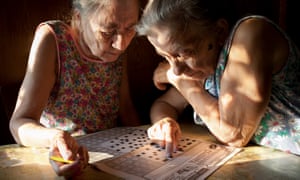

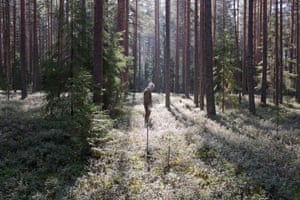

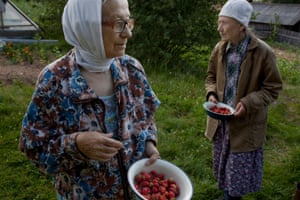
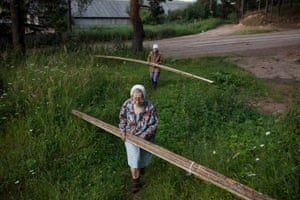
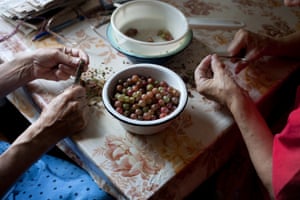

No comments:
Post a Comment